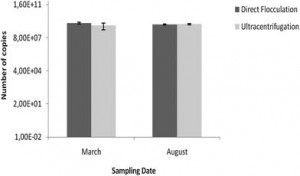Dana Lindsay and colleagues at Manhattan College, USA, have conducted a study to better understand the rate and extent of carcinogenic CrVI generation following the disinfection of drinking water with chlorine. Trace amounts of CrIII may be present in water supplies, but the extent to which this is oxidised to CrVI is poorly understood. Lindsay and colleagues found that oxidation occurred within a matter of hours, and therefore could occur during water treatment plants, but plateaued at less than 100% conversion, even with relatively high doses of chlorine.
Oxidation of CrIII to CrVI during chlorination of drinking water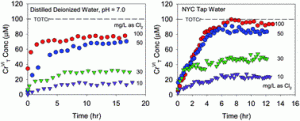
Dana R. Lindsay , Kevin J. Farley and Richard F. Carbonaro
J. Environ. Monit., 2012, Advance Article
DOI: 10.1039/C2EM00012A
Understanding the fate and transport of engineered nanoparticles in the environment is a key issue, this paper Jeffery Nason et al. have investigated the effect of natural organic matter on the stabilisation of nanoparticles in aquatic environments. Their findings indicate that both the type and concentration of the organic matter, along with the ionic strength of the aquatic system are important factors in determining colloidal nanoparticle stability.
Effects of natural organic matter type and concentration on the aggregation of citrate-stabilized gold nanoparticles
Jeffrey A. Nason , Shannon A. McDowell and Ty W. Callahan
J. Environ. Monit., 2012, Advance Article
DOI: 10.1039/C2EM00005A
Both these papers are free to access for 4 weeks following a simple registration for individual users.












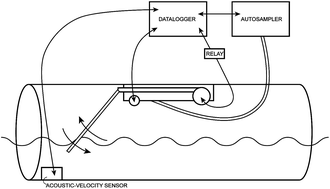 William Selbig, Amanda Cox and Roger Bannerman discuss the development of a new water sample collection system, to improve representation of solids entrained in urban stormwater by integrating water-quality samples from the entire water column, rather than a single, fixed point. They report that development of this new depth-integrated sample arm (DISA) was able to mitigate stratification bias resulting in a more accurate representation of stormwater-borne solids than traditional fixed-point sample collection methods.
William Selbig, Amanda Cox and Roger Bannerman discuss the development of a new water sample collection system, to improve representation of solids entrained in urban stormwater by integrating water-quality samples from the entire water column, rather than a single, fixed point. They report that development of this new depth-integrated sample arm (DISA) was able to mitigate stratification bias resulting in a more accurate representation of stormwater-borne solids than traditional fixed-point sample collection methods.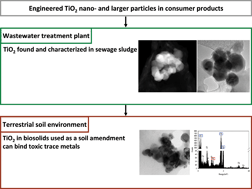 Bojeong Kim and colleagues from Virginia Tech and Duke University have investigated the characterization and environmental implications of nano- and larger TiO2 particles in sewage sludge and soils amended with sewage. They examined the most likely route of engineered TiO2 particles entering the soil environment by using analytical electron microscopic techniques, and provided detailed information regarding their occurrence, fate and behaviour in the sewage sludge materials and in mesocosm soils that had been amended with biosolid products.
Bojeong Kim and colleagues from Virginia Tech and Duke University have investigated the characterization and environmental implications of nano- and larger TiO2 particles in sewage sludge and soils amended with sewage. They examined the most likely route of engineered TiO2 particles entering the soil environment by using analytical electron microscopic techniques, and provided detailed information regarding their occurrence, fate and behaviour in the sewage sludge materials and in mesocosm soils that had been amended with biosolid products.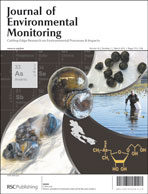 On the outside front cover of JEM
On the outside front cover of JEM 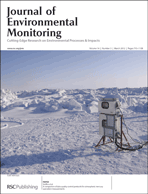 On the inside front cover is a HOT article from Alexandra Steffen and colleagues from Environment Canada and the National Atmospheric Deposition Program (NADP) at the University of Illinois, reporting on a comparison of their data quality control protocols for the measurement of atmospheric mercury species. The protocols RDMQ™ and AMQC were developed independently by Environment Canada and the NADP respectively, and have been assessed by the criteria on which the data is quality controlled and comparability of the final data products.
On the inside front cover is a HOT article from Alexandra Steffen and colleagues from Environment Canada and the National Atmospheric Deposition Program (NADP) at the University of Illinois, reporting on a comparison of their data quality control protocols for the measurement of atmospheric mercury species. The protocols RDMQ™ and AMQC were developed independently by Environment Canada and the NADP respectively, and have been assessed by the criteria on which the data is quality controlled and comparability of the final data products. Anne Sleeuwenhoek and John Cherrie at the Institute of Occupational Medicine, Edinburgh have developed a method to reconstruct exposure to tetrafluoroethylene (TFE) and ammonium perfluorooctanoate (APFO) in plants producing polytetrafluoroethylene (PTFE).
Anne Sleeuwenhoek and John Cherrie at the Institute of Occupational Medicine, Edinburgh have developed a method to reconstruct exposure to tetrafluoroethylene (TFE) and ammonium perfluorooctanoate (APFO) in plants producing polytetrafluoroethylene (PTFE).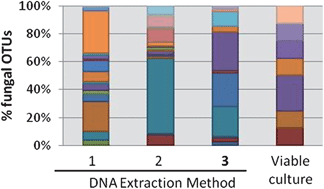 William Rittenour et al. have compared three commonly used DNA extraction methodologies used in ITS sequencing of occupational or environmental dust samples, in order to assess fungal diversity and exposure.
William Rittenour et al. have compared three commonly used DNA extraction methodologies used in ITS sequencing of occupational or environmental dust samples, in order to assess fungal diversity and exposure.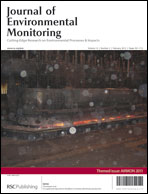 Welcome to our second issue of the year, which includes a collection of articles from
Welcome to our second issue of the year, which includes a collection of articles from 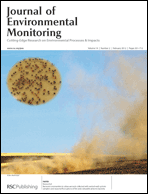 The second is from Subbarao V. Ravva et al. on the sampling and influence of environmental conditions on airborne bacteria:
The second is from Subbarao V. Ravva et al. on the sampling and influence of environmental conditions on airborne bacteria: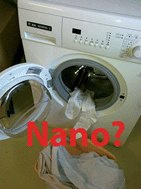 The release of engineered nanomaterials to the environment
The release of engineered nanomaterials to the environment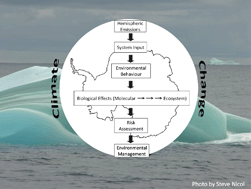 Persistent organic pollutants in Antarctica: current and future research priorities
Persistent organic pollutants in Antarctica: current and future research priorities 


